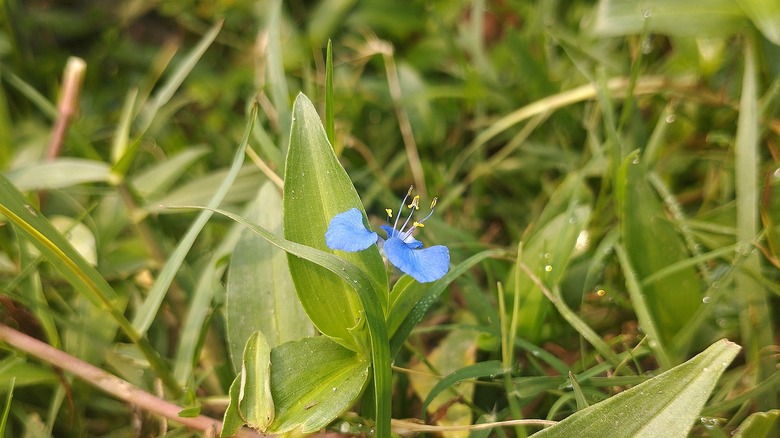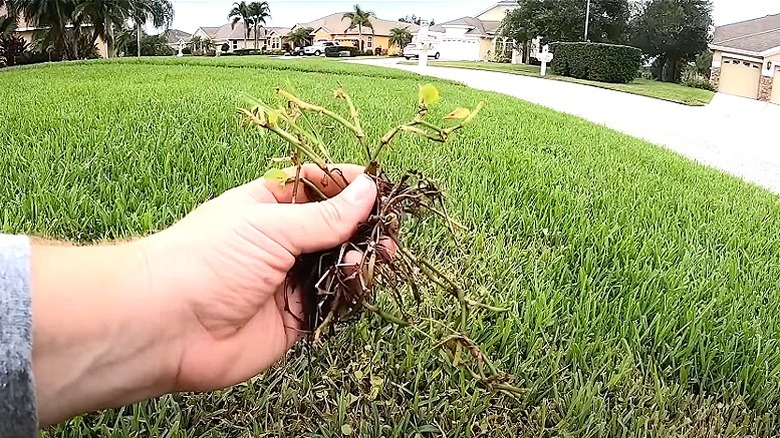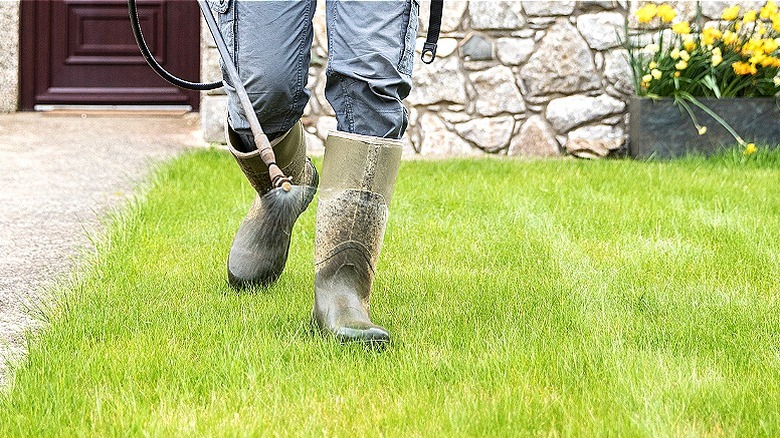How To Keep Dayflowers Out Of Your Lawn
We may receive a commission on purchases made from links.
Lawn care feels like an intense game of chess when the battleground shifts from mowing and watering to weed control, particularly when dealing with an unyieldingly stubborn invader like dayflower weed. With different species originating from the Americas and East Asia, these tenacious plants sport lance-shaped leaves complemented by blue and greenish-white, day-long blooms. They have a soft spot for rich, well-drained soil in partial shade to full sun, and with edible stems and leaves, dayflowers can double as an impromptu salad.
However, keeping dayflowers out of your lawn can become a titanic struggle. While the weed's impact on the ecosystem is minimal to nil, its flowers are rapid-fire seed factories, launching their progeny far and wide. The seeds can lie dormant for years, springing back to life when conditions are right, mirroring a suburban "Game of Thrones" episode. This defying spirit of dayflowers is further amplified by being resistant; even a snapped stem can continue to sprout, not to mention the formidable root system that anchors it all.
Now, for the million-dollar question: How do you control spreading dayflowers on your lawn? Hand-pulling is your best bet. However, timing and technique are critical here. Regarding the chemical route, brace yourself for an unpleasant revelation, as dayflowers laugh in the face of conventional weed killers. But hope springs, as a combination of sulfentrazone and cloransulam-methyl seems to do the trick.
How to get rid of dayflowers naturally
Every lawn weed story has its heroes, villains, and arsenal. Regarding the dayflower, you're the knight in shining armor, and the weapon isn't some fiery sword but the strength of your grip. Manually yanking out these floral pests may not be glamorous, but it enters the Hall of Fame in highly effective dayflower management. The challenge inherent in this procedure is that dayflowers multiply from fragments left in the soil. The key to belittling this magic trick lies in timing: Catch them before they reproduce. Dry soil makes the dayflowers drama queens, as they turn brittle, break off at the roots, and leave the soil primed for a sequel. That's why a sodden rendezvous comes highly recommended for easier root extraction. You can water your lawn before the operation, or better yet, wait for a downpour — Mother Nature's way of preparing the battlefield for you.
Now, onto launching your attack. Grip firmly at the base of each pesky violator, muster a war hero's determination, and pull gently yet persistently to rid your lawn of the entire dayflower weed and its root system — no half-measures here. Depending on the scale of the invasion, this won't be a one-day spectacle. Treat it like a suspenseful mini-series with manageable yet frequent sessions. In addition, carefully discard the uprooted weeds, as a remnant stem or root can trigger a chain reaction of resurrection. You also want to keep a watchful eye, ensuring no sprouts survive to reclaim territory.
Best herbicides for dayflower weeds in lawns
What kills dayflowers, you ask? Well, the familiar postemergence weed control ally, glyphosate, sadly holds no sway over the dayflower weed. There's still hope, though, for available is a unique arsenal of chemicals that can turn the tide of the war against dayflowers. Enter select postemergence herbicides. The secret lies in the deadly synergy of sulfentrazone and cloransulam-methyl. When used in tandem, these potent infusions serve as your ultimate line of defense. A worthy recommendation for sulfentrazone-laced herbicide for dayflowers is the Bonide Sedge Ender Weed Control Concentrate, available on Amazon. It's a multitasking marvel boasting capabilities to conquer pre- and post-emergent weeds on cold and warm-season grass lawns.
Such chemicals are amazing when aimed at the intended foes, not your skin or eyes. So, proper PPE will suffice. However, the effectiveness hinges on more than the herbicide composition: Several factors are vital for sending dayflowers to their doom. For one, young, actively growing weeds make for prime targets, so strike when the iron is hot. But watch for water stress, particularly under the harsh afternoon sun, as it can severely impair the herbicide's killing power, rendering it futile. For this reason, launch your chemical warfare early in the day, post the morning dew's evaporation. Plus, well-timed reapplications based on the herbicide manufacturer's recommendations may be necessary for the utmost control of dayflower weeds in your lawn. Regarding prevention measures, spending extra energy and resources to nurture a thick and vibrant turf could create a domino effect that smoother those green intruders.


